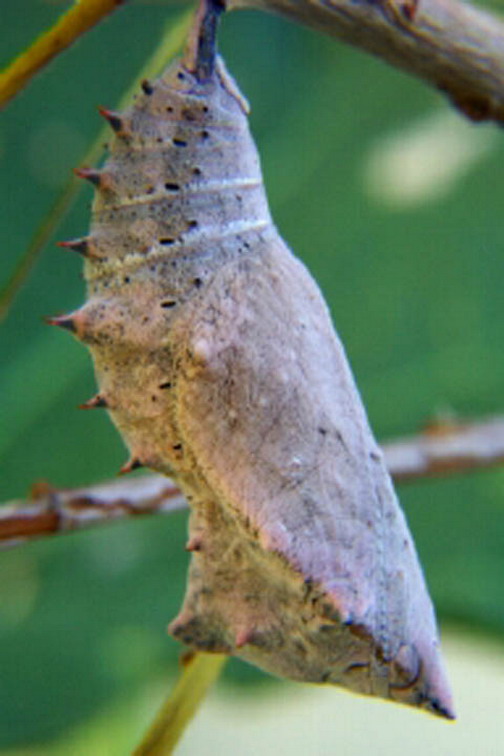When I was in the 7th grade I found a caterpillar at school. I took it to my teacher Miss McGowan who told me that it was a Mourning Cloak and that I could feed it mulberry leaves. I remember its spiky ‘fur’ and the way it’s sticky little feet felt on my fingers. I took it home, put it in a glass box with a dirt floor, a stick to climb on and a screen top.

On April 1st, it spun a chrysallis! I was really excited and told my best friend. She didn’t believe me at first (April Fool’s Day, of course).

A couple of weeks later, on Easter Sunday morning, the butterfly started to emerge from it’s chrysallis. I was up early with my Mom and we sat on the back porch steps together and watched it. It came out from it’s protective outer case, unfurled it’s wings and after they had dried, it fluttered away into the Spring morning.

My family didn’t go to church, but had a sort of underlying spiritual awareness. I remember my Mom saying that morning what a miracle we had witnessed and that this is the true meaning of Easter: rebirth, resurrection, new life.
It was a special thing to share with her and I feel that in those moments watching the butterfly emerge transformed and through the words spoken by my Mom, I learned about the deepest meaning of Easter.
I looked into the symbolism of the Mourning Cloak butterfly. It is also known as Harbinger of Spring, being one of the first butterflies to emerge, and as the Camberwell Beauty in Britain. These butterflies live for about a year, overwinter as an adult in a hibernaculum and reappear in springtime to mate.
The name Mourning Cloak is due to the appearance of the dorsal surface of the wings, said to resemble the traditional cloak worn by those in mourning, which was sometimes draped over the casket of the deceased. This is very poignant and meaningful to me. My Mom died from cancer in 1980, four years after the Easter of the Mourning Cloak. As a family we didn’t cope very well and never went through a mourning period together. I suppose we each dealt with her death in our own way. It was such a long time ago and although I’ve done a lot over the years to come to terms with it, at times I still feel cloaked in grief.

Victorian mourning cloak, black silk and velvet, 1890.
This beautiful wool flannel Mourning Cloak is from Twin Roses Designs.


The Journey of Mourning Cloak, Ernst Kreidolf, 1911.
Nymphalis antiope – The generic name is from the Greek nymphe, which was the name given in both Roman and Greek mythology to any of a number of minor nature goddesses who were young and beautiful, living in rivers, mountains, or trees. The reference here is to the goddess-like sylvan nature of the Mourning Cloak. Antiope was a noted beauty of Greek mythology who was seduced by Zeus in the form of a Satyr. She bore two sons, Amphion and Zethos, the founders of the Greek city of Thebes. The species name antiope creates a tautonym, as both of the scientific names of the Mourning Cloak refer to its embodiment of mythological beauty.

Jupiter and Antiope, Antoine Watteau, 1715.
Image & info sources –
What’s That Bug?
Hiker’s Notebook
The Art of Pierangelo
Wikipaintings

Interesting…I enjoyed reading your post. Sometimes I think it would be better if there were some way to identify those who are going through deep grief, such as the mourning cloak used in Victorian times. Nowadays, we are expected to “move right along” in our grief, shortchanging ourselves of the time necessary to grieve our losses.
❤️
Yes Rebecca. This would also allow others to witness that we/others grieve and that loss is a part of being alive.
Thank you for your words.
I agree Rebecca. Our society is so uncomfortable with everything surrounding death, including the fact of it. After 30 years, it still sometimes surprises me how deep the loss is.
I live at the edge of the woods in southern Maine. Each year, I watch for the first mourning cloak to come out. This year, is was almost three weeks early. I loved reading where the butterfly got the name. Thanks so much.
Love this